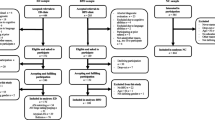Abstract
According to the empirical literature, there are high rates of borderline personality disorder (BPD) among individuals with formal diagnoses of eating disorders, and high rates of eating disorders among individuals with BPD. In this study, we examined relationships between three eating disorder symptoms (i.e., binge eating, starving oneself, abusing laxatives) and borderline personality symptomatology according to two self-report measures (the borderline personality scale of the Personality Diagnostic Questionnaire-4 and the Self- Harm Inventory) in a sample of psychiatric inpatients (N=126) and in a sample of internal medicine outpatients (N=419). Each individual eating disorder item, as well as a composite score of all three items, demonstrated statistically significant correlations with both measures of borderline personality symptomatology in both samples. In addition, endorsement of all three symptoms was invariably associated with borderline personality symptomatology on both measures. Specific eating disorder symptoms, alone, may predict for borderline personality symptomatology.
Similar content being viewed by others
References
Sansone RA, Levitt JL, Sansone LA. The prevalence of personality disorders in those with eating disorders. In: Sansone RA, Levitt JL (Eds) Personality Disorders and Eating Disorders. Exploring the Frontier. New York, Routledge, 2006, pp 23–39.
Zanarini MC, Frankenburg FR, Dubo ED, et al. Axis I comorbidity of borderline personality disorder. Am J Psychiatry 1998; 155: 1733–9.
Zimmerman M, Mattia JI. Axis I diagnostic comorbidity and borderline personality disorder. Compr Psychiatry 1999; 40: 245–52.
Johnson DM, Shea MT, Yen S, et al. Gender differences in borderline personality disorder: findings from the Collaborative Longitudinal Personality Disorders Study. Compr Psychiatry 2003; 44: 284–92.
Zanarini MC, Frankenburg FR, Hennen J, et al. Axis I comorbidity in patients with borderline personality disorder: 6-year follow-up and prediction of time to remission. Am J Psychiatry 2004; 161: 2108–14.
Conklin CZ, Westen D. Borderline personality disorder in clinical practice. Am J Psychiatry 2005; 162: 867–75.
Tadic A, Wagner S, Hoch J, et al. Gender differences in axis I and axis II comorbidity in patients with borderline personality disorder. Psychopathology 2009; 42: 257–63.
Ritter K, Roepke S, Merkl A, et al. Comorbidity in patients with narcissistic personality disorder in comparison to patients with borderline personality disorder. Psychother Psychosom Med Psychol 2010; 60: 14–24.
Hudson JI, Hiripi E, Pope HG, et al. The prevalence and correlates of eating disorders in the National Comorbidity Survey Replication. Biol Psychiatry 2007; 61: 348–58.
Hyler SE. Personality Diagnostic Questionnaire-4. New York, New York State Psychiatric Institute, 1994.
American Psychiatric Association. Diagnostic and Statistical Manual of Mental Disorders, Fourth Edition. Washington, DC, American Psychiatric Association, 1994.
Dubro AF, Wetzler S, Kahn MW. A comparison of three self-report questionnaires for the diagnosis of DSM-III personality disorders. J Pers Disord 1988; 2: 256–66.
Hyler SE, Lyons M, Rieder RO, et al. The factor structure of self-report DSM-III Axis II symptoms and their relationship to clinicians’ ratings. Am J Psychiatry 1990; 147: 751–7.
Johnson JG, Bornstein RF. Utility of the Personality Diagnostic Questionnaire-Revised in a nonclinical sample. J Pers Disord 1992; 6: 450–7.
Patrick J, Links P, Van Reekum R, et al. Using the PDQR BPD scale as a brief screening measure in the differential diagnosis of personality disorder. J Pers Disord 1995; 9: 266–74.
Sansone RA, Wiederman MW, Sansone LA. The Self- Harm Inventory (SHI): development of a scale for identifying self-destructive behaviors and borderline personality disorder. J Clin Psychol 1998; 54: 973–83.
Kolb JE, Gunderson JG. Diagnosing borderline patients with a semistructued interview. Arch Gen Psychiatry 1980; 37: 37–41.
Thompson-Brenner H, Eddy KT, Satir DA, et al. Personality subtypes in adolescents with eating disorders: validation of a subclassification approach. J Child Psychol Psychiatry 2008; 49: 170–80.
Westen D, Harnden-Fischer J. Personality profiles in eating disorders: rethinking the distinction between axis I and axis II. Am J Psychiatry 2001; 158: 547–62.
Thompson-Brenner H, Eddy KT, Franko DL, et al. A personality classification system for eating disorders: a longitudinal study. Compr Psychiatry 2008; 49: 551–60.
Author information
Authors and Affiliations
Rights and permissions
About this article
Cite this article
Sansone, R.A., Chu, J.W., Wiederman, M.W. et al. Eating disorder symptoms and borderline personality symptomatology. Eat Weight Disord 16, e81–e85 (2011). https://doi.org/10.1007/BF03325313
Received:
Accepted:
Published:
Issue Date:
DOI: https://doi.org/10.1007/BF03325313




